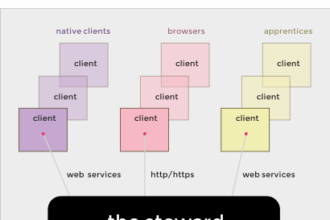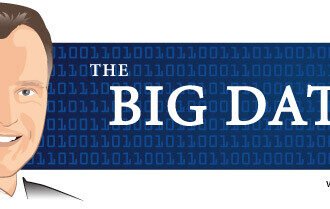 There’s an elephant in the room. No, not the friendly, yellow, Hadoop variety.
There’s an elephant in the room. No, not the friendly, yellow, Hadoop variety.
The large, smelly, excrement-dumping kind that no one wants to notice, never mind talk about. Allow me to name it: the combination of big data and the Internet of Things (IoT) is reinventing the nature of work. Much of employment as we know it is disappearing. And that signals the end of the consumer society we’ve painstakingly built over the past half century or so.
Am I being alarmist? Let’s think about where big data and the IoT are going and how they are intersecting with the world of people earning and spending money. Include all the automation, connectivity and analytics that we are doing and considering. And you’ll soon see what I mean. In part 1 of this short series, I look at the current state of play for big data and the Internet of Things.
Let’s start with the physical. The Things of the IoT are acquiring ever more sensing abilities, as well as an increasing level of automation capabilities. Think piece-part robots yalking via the Internet and you wouldn’t be far wrong. Look also at the developments in robotics in the past few years. In a recent O’Reilly Radar article, Rodney Brooks, former Panasonic Professor of Robotics at MIT and founder of Rethink Robotics, says “We’re at the point with production robots where we were with mobile robots in the late 1980s… The advances are accelerating dramatically.” The Rethink Robotics videos show some agonizingly slow-motion action, but it doesn’t need Clayton Christensen to recognize a potential disruptive innovation here. The process about to be disrupted is the manual labor involved in a whole variety of repetitive but loosely bounded activities on assembly, packaging and similar production lines. Their manufacturers promote the idea that these new robots can work safely alongside humans, but the cost equation speaks more to replacement of manual labor than coexistence. Even at this early stage of development, Rethink Robotics’ Baxter sells from $25,000. The impact on employment seems fairly obvious.
 Brooks, quoted in the same Radar article by Glen Martin, also targets robots for health care, especially care of the elderly, suggesting that demand for such workers is outstripping supply. “Again, the basic issue is dignity. Robots can free people from the more menial and onerous aspects of elder care, and they can deliver an extremely high level of service, providing better quality of life for seniors.” And even less of the desperately needed social interaction that alleviates loneliness and disconnection among the elderly, given the more likely staff replacement vs supporting robotic role. Although you shouldn’t discount YDreams Robotics‘ forthcoming desk lamp, which can sense your mood and call a friend or relative via smartphone and tell them you’re in need of cheering up. The scenarios get creepier, right up to and including Spike Jonze’s new movie, her. But from the viewpoint of this blog, the bottom line is another set of jobs under threat.
Brooks, quoted in the same Radar article by Glen Martin, also targets robots for health care, especially care of the elderly, suggesting that demand for such workers is outstripping supply. “Again, the basic issue is dignity. Robots can free people from the more menial and onerous aspects of elder care, and they can deliver an extremely high level of service, providing better quality of life for seniors.” And even less of the desperately needed social interaction that alleviates loneliness and disconnection among the elderly, given the more likely staff replacement vs supporting robotic role. Although you shouldn’t discount YDreams Robotics‘ forthcoming desk lamp, which can sense your mood and call a friend or relative via smartphone and tell them you’re in need of cheering up. The scenarios get creepier, right up to and including Spike Jonze’s new movie, her. But from the viewpoint of this blog, the bottom line is another set of jobs under threat.
Information-based jobs are no safer, also under threat from multiple directions. Simpler tasks are automated. Sports scores and stock market prices can be spun into passable stories already by automated processes, once the jobs of cub journalists. More complex tasks are dissected into component parts, with the simpler parts automated and the human role often restricted to repetitive or supervisory activities. This is much the same process that took place in industrial factories in the 19th century. Craft workers who, skillfully and lovingly, made complete finished articles were displacing by production workers whose activities were increasingly optimized to produce simple piece parts in the cheapest and most soulless manner. Pattern recognition and machine learning have seen enormous advances as training data sets become ever larger. Human translators are being displaced by Google Translate and its ilk. According to Frey’s and Osborne’s estimate in their 2013 The Future of Employment, “47 percent of total US employment is in the high risk category, meaning that associated occupations are potentially automatable over some unspecifed number of years, perhaps a decade or two. It shall be noted that the probability axis can be seen as a rough timeline, where high probability occupations are likely to be substituted by computer capital relatively soon.” The probabilities produced by their model run from 99% for telemarketers, freight agents, tax preparers and more to 0.3% for emergency management directors and first line supervisors. Frey and Osborne cover both physical and information-based jobs, but it’s interesting to note how many information-based jobs are in the high probability range. It’s also worth noting how much of the “services industry”, that darling of developed Western economies, falls in the higher ranges of probability.
So, there is a problem here. Current technological trends will very clearly impact employment and society. The IT industry is confident that net effect will be positive. Many economists seem to be fence-sitting… but that’s fairly normal. However, we’ll take a closer look in Parts 2 and 3.
For a broader and deeper view of the business and technological aspects of this topic, please take a look at my new book: Business unIntelligence: Insight and Innovation Beyond Analytics and Big Data.








